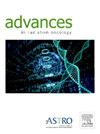Preoperative Stereotactic Radiosurgery for Brain Metastases: A Phase 1 Dose Escalation Study Demonstrating Reduced Leptomeningeal Disease
IF 2.7
Q3 ONCOLOGY
引用次数: 0
Abstract
Purpose
Preoperative stereotactic radiosurgery (SRS) has been proposed as a strategy to reduce nodular leptomeningeal disease (nLMD) after resection of brain metastases by devitalizing tumor cells before surgical manipulation. This study aimed to determine the safety of preoperative SRS via a phase 1 dose escalation trial and compare outcomes—including nLMD, classical LMD, local control, and overall survival (OS)—between preoperative and postoperative treatment cohorts.
Methods and Materials
A phase 1 trial evaluated the safety of single-fraction preoperative SRS at escalating doses (12 and 15 Gy) in patients with tumors 2 to 6 cm. Adverse events were assessed per National Cancer Institute Common Terminology Criteria for Adverse Events v4.0, with dose-limiting toxicity (DLT) defined as high-grade neurologic or wound complications. Retrospective analysis included an expanded preoperative cohort (n = 95) and a historical postoperative cohort (n = 107). Outcomes were analyzed with Kaplan-Meier and Cox proportional hazards models.
Results
Fifteen Gy was well tolerated in the phase 1 cohort, with no DLTs in larger tumors (4-6 cm) and 3 DLTs in smaller tumors, not meeting thresholds for dose de-escalation. In the expanded analysis, preoperative SRS significantly reduced rates of nLMD (7.4% vs 27.1%, P = .002), while rates of classical LMD (4.2% vs 4.5%) and local failure (14.6% vs 18.7%) were similar between groups. OS was also similar (median 12.8 vs 12.3 months). Multivariable analysis confirmed preoperative SRS as protective against nLMD (hazard ratio = 0.18, 95% CI, 0.07-0.43, P < .001).
Conclusions
Preoperative SRS to 15 Gy is safe for tumors 2 to 6 cm and significantly reduces nLMD without compromising local control or OS. These findings support preoperative SRS as a viable treatment strategy and justify further investigation into optimal dosing and patient selection.
术前立体定向放射治疗脑转移瘤:1期剂量递增研究显示轻脑膜疾病减轻
目的术前立体定向放射手术(SRS)被认为是一种通过在手术前激活肿瘤细胞来减少脑转移灶切除术后结节性轻脑膜病(nLMD)的策略。本研究旨在通过1期剂量递增试验确定术前SRS的安全性,并比较术前和术后治疗队列的结果,包括nLMD、经典LMD、局部控制和总生存期(OS)。方法和材料一项1期试验评估了肿瘤2 - 6 cm患者术前单组分SRS剂量递增(12 Gy和15 Gy)的安全性。不良事件按照美国国家癌症研究所不良事件通用术语标准v4.0进行评估,剂量限制性毒性(DLT)定义为高级神经或伤口并发症。回顾性分析包括扩大术前队列(n = 95)和术后历史队列(n = 107)。采用Kaplan-Meier和Cox比例风险模型对结果进行分析。结果在1期队列中,15 Gy耐受性良好,较大肿瘤(4-6 cm)中无dlt,较小肿瘤中有3例dlt,未达到剂量递减阈值。在扩展分析中,术前SRS显著降低了nLMD的发生率(7.4% vs 27.1%, P = 0.002),而经典LMD的发生率(4.2% vs 4.5%)和局部失败率(14.6% vs 18.7%)在两组之间相似。OS也相似(中位12.8个月vs 12.3个月)。多变量分析证实术前SRS对nLMD有保护作用(风险比= 0.18,95% CI, 0.07-0.43, P < 0.001)。结论15 Gy的SRS对2 ~ 6 cm的肿瘤是安全的,在不影响局部控制和OS的情况下可显著降低nLMD。这些发现支持术前SRS作为可行的治疗策略,并证明进一步研究最佳剂量和患者选择是合理的。
本文章由计算机程序翻译,如有差异,请以英文原文为准。
求助全文
约1分钟内获得全文
求助全文
来源期刊

Advances in Radiation Oncology
Medicine-Radiology, Nuclear Medicine and Imaging
CiteScore
4.60
自引率
4.30%
发文量
208
审稿时长
98 days
期刊介绍:
The purpose of Advances is to provide information for clinicians who use radiation therapy by publishing: Clinical trial reports and reanalyses. Basic science original reports. Manuscripts examining health services research, comparative and cost effectiveness research, and systematic reviews. Case reports documenting unusual problems and solutions. High quality multi and single institutional series, as well as other novel retrospective hypothesis generating series. Timely critical reviews on important topics in radiation oncology, such as side effects. Articles reporting the natural history of disease and patterns of failure, particularly as they relate to treatment volume delineation. Articles on safety and quality in radiation therapy. Essays on clinical experience. Articles on practice transformation in radiation oncology, in particular: Aspects of health policy that may impact the future practice of radiation oncology. How information technology, such as data analytics and systems innovations, will change radiation oncology practice. Articles on imaging as they relate to radiation therapy treatment.
 求助内容:
求助内容: 应助结果提醒方式:
应助结果提醒方式:


